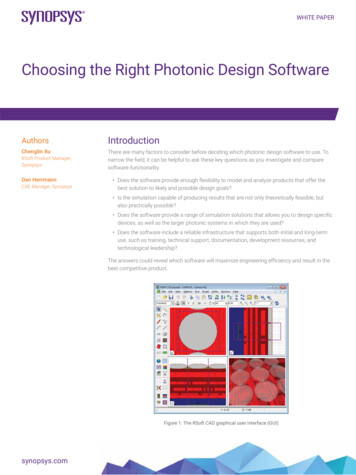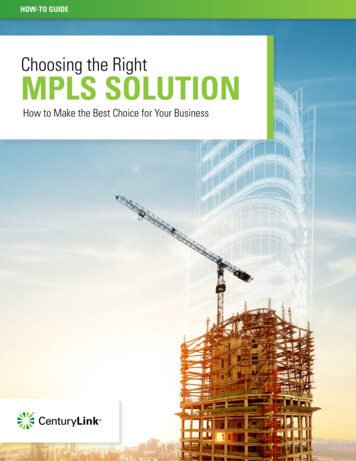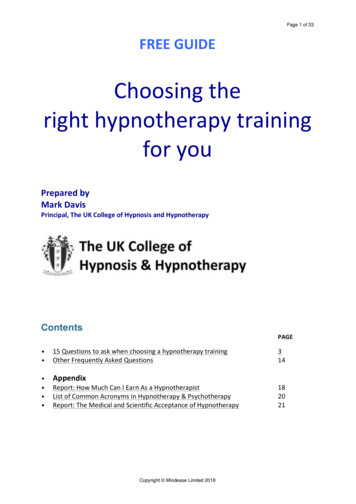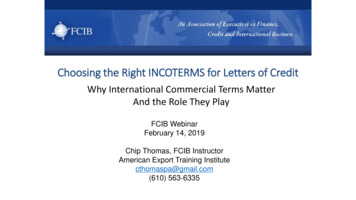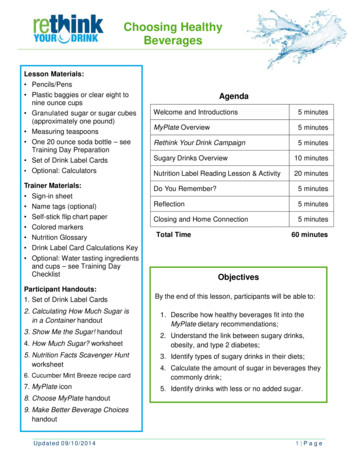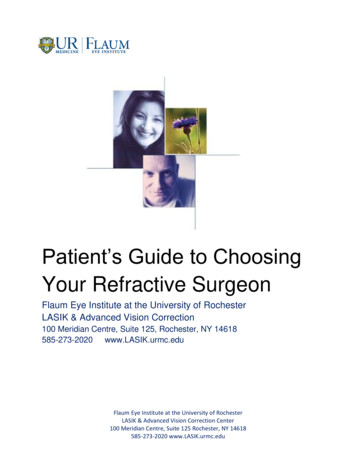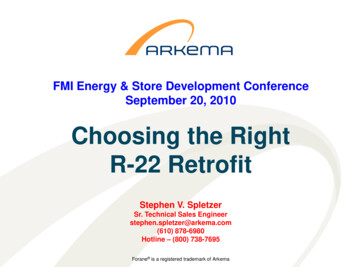
Transcription
FMI Energy & Store Development ConferenceSeptember 20, 2010Choosing the RightR-22 RetrofitStephen V. SpletzerSr. Technical Sales Engineerstephen.spletzer@arkema.com(610) 878-6980Hotline – (800) 738-7695Forane is a registered trademark of Arkema
Discussion Topics Phase-out / Transition Strategy R-22 Retrofits– General Retrofit Issues– Component Comparisons– Functional Considerations– Operating Traits Comparison Retrofit RecommendationsFMI – 2010 Energy & Store Development Conference
R-22 Phase-Out ScheduleFMI – 2010 Energy & Store Development Conference
R-22 Transition Strategy Service as usual– Refrigerant price / availability– Leaks Replacement– Initial equipment costs– Energy savings– Refrigerant recovery Retrofit– Refrigerant / equipment / labor costs– Refrigerant recovery– Energy costsFMI – 2010 Energy & Store Development Conference
R-22 Replacement RefrigerantsAir ConditioningRefrigerationFMI – 2010 Energy & Store Development Conference
The Truth About R-22 Retrofits None work as well as R-22 OVERALL None are as efficient as R-22 OVERALL None are “Drop-Ins” None are miscible with MO or AB None will work in every R-22 systemFMI – 2010 Energy & Store Development Conference
Elastomer Changes R-22 vs. HFCs with elastomers May need to change seals during retrofit––––––– Schrader valves / capsBall valvesSolenoid valvesEPRsFilter-driersSight glassesReceiver level gagesLeak check after retrofitFMI – 2010 Energy & Store Development Conference
Blend Issues Charge all blends as liquid Azeotropes / Near-azeotropes(R-507A / R-404A)– Fractionation from leaks small– May be suitable forflooded systems Zeotropes– Running / dormant systems– Typically not suitable for flooded systemsFMI – 2010 Energy & Store Development Conference
Discharge Temperature Effects R-22 suffers from high discharge temps– May exceed 300 F,@ high ambients / low temp Discharge temps of R-22 retrofits lower– Most typically 250 F,even @ high ambients / low temp Need for liquid injection, desuperheaters,& oil coolers reduced / eliminatedImproved capacity / efficiency for low tempFMI – 2010 Energy & Store Development Conference
R-22 Retrofit 4AR-438AR-507AEtc.FMI – 2010 Energy & Store Development Conference
Blend 8AR-434AR-438AR-507AR-32 -------------0.6-------------(weight .40.9----1.92.8---------FMI – 2010 Energy & Store Development dded-----------------------------------------
HFC Component ComparisonR-32R-125Cond. Pressures (%) 1 62 31 19- 34V. R. Capacity (%) 1 60 7 5- 38COP (%) 1-5- 11-7 0.6Mass Flow Rate (%) 1- 36 84 25 8Discharge Temps ( F) 1 34- 51- 46- 36GWP (100 year) 2675350044701430Flammability 3A2LA1A2LA1MO / AB SolubilityVery PoorVery PoorPoorVery PoorR-143a R-134a1 – Relative to R-22, Standard Cycle @ 105 F Condenser, 25 F Evaporator, 10 F of Superheat & Subcooling2 – From the IPCC AR43 – L Sub-classification Under Public ReviewFMI – 2010 Energy & Store Development Conference
GWP ComparisonFMI – 2010 Energy & Store Development ConferenceR-507AGlobal Warming Potential (100 -424A2500R-417B3000R-428A3500R-404A4000
High Side Pressure ComparisonBased on Standard Cycle 105 FCondenser, 25 F Evaporator,10 F Subcooling & 10 F Superheat-240-10 10R-438A ch lower pressureR-428A R-421BLower pressureSimilar pressureHigher pressure 24R-434A R-422AR-417AR-407F R-422CMuch higher pressureR-507ACondenserPressure ChangeRelative to R-22-60(psig)FMI – 2010 Energy & Store Development ConferenceR-417B 60
Refrigerant CapacitiesCapacity Relative to R-22 (%)110R-404AR-407AR-427AR-422BR-417A10510095Based on Standard Cycle25 F Evaporator,10 F Subcooling& 10 F Superheat90858075708090100110120Condenser Temperature ( F)FMI – 2010 Energy & Store Development Conference130
Refrigerant Flow Rate Issues Most R-22 retrofits require significantlyhigher refrigerant flow rates than R-22Flow considerations for retrofit–––––TXVsPistons, orifices, cap tubesDistributor nozzlesLine setsCompressor valve platesFMI – 2010 Energy & Store Development Conference
Mass Flow 22CBased on Standard Cycles65 - 105 F Condenser,25 F Evaporator,10 F Subcooling,& 10 F FR-407CR-407AR-404A90100 110120 130 140 150160 170 180 190 200Refrigerant Flow Rates (% Relative to R-22)FMI – 2010 Energy & Store Development Conference210
POE Oil Change Issues Labor & expense of oil change– Retrofit procedures Solvency effects– Filter changes– Elastomers Flushes– Multiple flushes often not required Oil separators Dirty installations Oil concentration / purity Performance improvementFMI – 2010 Energy & Store Development Conference
Oil Change Trade-Offs“No Oil DR-434AR-421AR-422BR-424AR-438AOil Change to POER-404AR-407CR-427AR-407AR-407FR-507AProsLower Upfront CostQuicker RetrofitNo “POE Issues”ProsReduced Oil LoggingReliable Oil ReturnBest Performance% R-32 & R-143a0 – 20% R-32 & R-143a20 – 52FMI – 2010 Energy & Store Development Conference
Immiscibility Issues - Oil Hold-UpOIL-RICH LAYERLIQUID REFRIGERANTFMI – 2010 Energy & Store Development Conference
Immiscibility Issues - Oil Logging1234FMI – 2010 Energy & Store Development Conference5
Test Set-UpEvaporator UnitCondensing Unit 1-½ HP R-22 condensing unit / evaporator assembly Horizontal line-set sloped down from evaporator compressor Optimized refrigerant charge / adjusted TXV superheat setting Ran R-422D, R-427A, and R-438A with MO & POE (camera) 100 F Ambient / 0, 25, & 50 F Box Temps – “Dry Coil” testsFMI – 2010 Energy & Store Development Conference
Test Data – Oil Return SSR-438AFAILPASSFMI – 2010 Energy & Store Development Conference
Test Data – MO RunsRefrigerating Capacity (Btu/hr)16000R-422D / MOR-427A / MOR-438A / MO140001200010000800060004000025Box Temperature ( F)FMI – 2010 Energy & Store Development Conference50
Test Data – MO vs. POE RunsRefrigerating Capacity (Btu/hr)16000R-422D / MOR-427A / MOR-438A / MOR-422D / POER-427A / POER-438A / POE140001200010000800060004000025Box Temperature ( F)FMI – 2010 Energy & Store Development Conference50
R-22 Retrofit Metrics*Capacity (%) 25COP (%) 25 15MFR (%) 15 75R-421B 15 5R-407FR-507AR-428AR-404A0 15 9 9 5 3 3R-407A000R-407CR-422A-5 R-421B R-422C-5-3 R-427A -3R-407CR-434AR-407A R-407FR-438AR-417B R-427AR-417AR-421A R-424AR-422BR-438AR-422DR-507AR-422D-15-15-9 R-404A R-434A-9R-417BR-421BR-422B R-422C R-422AR-421ADischarge P (psi) 75 75R-428A R-422AR-422CR-417B 75Suction P (psi) 25R-428A 25Discharge T ( F) 75 75 45 45 15 15R-428AR-507AR-507A 45 R-434A 45 45 45 15 15R-422D R-507AR-404A 422CR-424AR-417AR-417B R-407A R-434AR-421B R-422CR-434AR-438AR-407F 15 15 15 15 5 -407CR-438AR-407FR-407C R-422DR-427A-15-15-15 R-421A -15-5 R-438A -5R-422BR-424AR-417AR-422BR-421AR-417A0R-407F-15 R-407C -15R-407A -438AR-507AR-417A R-404A 417BR-422A R-422CR-428AR-424AR-417A-25-25Capacity (%)-15-15COP (%)MFR (%)Discharge P (psi)Suction P (psi)-75Discharge T ( F)*Standard Cycle 105 F Condenser, 25 F Evaporator, 10 F Subcooling & 10 F SuperheatFMI – 2010 Energy & Store Development Conference-75
R-22 Retrofit Metrics*Capacity (%)COP (%)Mass Flow (%)Discharge P (psi)Suction P (psi)Discharge T ( F) 25 25 15 15 75 75 75 75 25 25 75 75 15 15 9 9 45 45 45 45 15 15 45 45 15 5 5 15 15R-407A 5 50R-407A0 30 3 150R-427A0R-407C 15R-407A0 15R-407CR-407A0R-427A0000R-407CR-407C-50-5R-427A-3 R-427AR-407CR-407A-3-15-15-15-15R-427A-5-5-15 R-407C -15R-407A 15-75-75-75-75-25-25-75-75Capacity (%)COP (%)Mass Flow (%)Discharge P (psi)Suction P (psi)Discharge T ( F)*Standard Cycle 105 F Condenser, 25 F Evaporator, 10 F Subcooling & 10 F SuperheatFMI – 2010 Energy & Store Development Conference
R-22 Retrofit RecommendationsR-407CR-407AR-427AApplicationAC, MTMT, LTAC, MT, LTProsClosest AC MatchNo TXV changesLowest GWPClosest MT MatchNo TXV changesLower GWPClose pressuresNo TXV changesLower GWPConsModerate HeadPressure Moderate HeadPressure Slight Capacity OilPOEPOEPOE(MO / AB)*LimitationsDX Systems OnlyDX Systems OnlyDX Systems Only* Successfully used with MO and AB with an Oil SeparatorFMI – 2010 Energy & Store Development Conference
Conclusions Need for R-22 retrofits growing Many R-22 retrofits– No “drop-ins” / No “1 answer” Understanding basic HFC components key todifferentiating products / advertising claims HCs help with oil – immiscibility issues remain R-407C, R-407A, & R-427A are good optionsFMI – 2010 Energy & Store Development Conference
Q&AThank You!FMI – 2010 Energy & Store Development Conference
Discharge Temperature Effects . High Side Pressure Comparison Based on Standard Cycle 105 F Condenser, 25 F Evaporator, 10 F Subcooling & 10 F Superheat 0-10 10-24 24-60 60 R-417A R-421A R-424A R-422B R-438A R-422D R-427A R-407C-407A R-422C R-404A R-428A R-421B R-434A R-422A R-507A (psig) Condenser Pressure Change Relative to R-22 Much lower pressure Lower pressure Similar pressure
